由2-甲基咪唑-4,5-二羧酸构筑的双核平行六面体三维钙配位聚合物
2013-09-15聂旭亮涂勇刚黄长干
聂旭亮 熊 辉 涂勇刚 黄长干*,
(1江西农业大学理学院,南昌 330045)
(2江西农业大学食品科学与工程学院,南昌 330045)
0 Introduction
In recent years,the design and synthesis of metal-organic frameworks(MOFs)have attracted much attention,not only owing to their intriguing variety of architectures but also because of their potential applications as microporous,magnetic,nonlinear optical,and fluorescent materials[1-5].The multifunctional organic ligands play an important role in constructing MOFs with unique structures and properties.Thus,considerable efforts have been devoted to choosing or designing various multifunctional bridging ligands[4-6].
Structures containing metals and N-heterocyclic carboxylic acids have attracted much attention as they can function as a multidentate ligand,exhibit diverse structural type and can be potentially used as functional materials[4-8].Over the past few years,extensive investigations have focused on the construction of MOFs using 4,5-imidazoledicarboxylic acid as the bridges[9-17].However,the reports of coordination polymers with 2-methyl-1H-imidazole-4,5-dicarboxylic acid are still rare[18-23].Recently,our group reported three 0D transition metal (cadmium,cobalt and nickel)complexes and a 2D (sodium)MOFs with the 2-methyl-1H-imidazole-4,5-dicarboxylic acid(H3MIA)ligand[19-23].Although cadmium,cobalt and nickel complexes have the same formula,they crystallize in three different crystal systems,and there are many differences in the structures.The 2D sodium MOFs shows a unique coordination mode and interesting 2D topology.Therefore,we have been engaged in synthesizing new MOFs with H3MIA ligand,and not long ago we obtained a calcium complex with H3MIA ligand via hydrothermal reaction.Herein,we report the synthesis and structure of the three-dimensional binuclear parallelepiped MOFs constructed by Ca(Ⅱ)with 2-methyl-1H-imidazole-4,5-dicarboxylatebuildingblocks.
1 Experimental
1.1 Materials and measurements
1,2-phenylenediamine,and other reactants of A.R.grade were obtained commercially and used without further purification.Elemental analysis of C,H and N was performed on a Perkin-Elmer 240C elemental analyzer.Infrared (IR)spectra were recorded (4 000~400 cm-1)as KBr disks on a Nicolet 6700 FT-IR spectrometer.Thermogravimetric analysis(TGA)experiments were carried out on a Perkin-Elmer TG/DTA 6300 system with a heating rate of 10℃·min-1from temperature to 800℃ under nitrogen atmosphere.
1.2 Synthesis of H 3MIA and complex 1
1.2.1 Synthesis of H3MIA
2-methylbenzimidazole was prepared from acetic acid and 1,2-phenylenediamine in 4 mol·L-1HCl as solvent at reflux for 40 min with a yield of 90%,using a modified Phillips reaction[24]and was recrystallized from ethanol.Then to 24.5 mL (0.46 mol)H2SO4(98%),2.64 g (0.02 mol)2-methylbenzimidazole was added under stirring at ambient temperature.After the reaction mixture became clear,a 10 mL(0.027 5 mol)solution of H2O2(30%)was added dropwise at 100℃with vigurous stirring,then the temperature was slowly elevated to 145 ℃ and maintained for 1 h.Theresulting mixture was slowly cooled to 100℃and poured into 100 g ice-cold water with rapidly stirring,then the resulting suspension was filtered and washed with water and ethanol,respectively.2.38 g(70%)H3MIA remained after drying in vacuo.m.p.285 ℃;IR(KBr,cm-1):3 541.9,3 461.6,2 915.9,1 591.9,1 557.6,1 268.4.MS(ESI)m/z:169.10(M+-1)(100%).H3MIA belongs to monoclinic crystal system,P21/c space group,a=0.848 97(7)nm,b=1.427 31(12)nm,c=0.652 81(5)nm,β=97.379 0(10)°[25].
1.2.2 Synthesis of complex 1
A mixture of CaCl2(0.021 9 g,0.1 mmol),H3MIA(0.034 g,0.2 mmol),NaOH (0.6 mL,0.65 mol·L-1),and distilled water (10 mL)was sealed in a Teflonlined stainless reactor(25 mL)and heated at 120℃for 72 h,and then cooled the autoclave to room temperature.The crystals were recovered,then filtered and washed with distilled water.The colorless crystals of 1 were obtained suitable for X-ray diffraction analysis with yield of 80%based on Ca(Ⅱ).Elemental Analysis Calcd.(%)for C12H10N4Ca2O10:C,31.86;H,2.67;N,12.38.Found(%):C,32.00;H,2.24;N,12.44.IR(KBr,cm-1):3 418.6,3 122.4,1 655.2,1 560.9,1 529.5,1 458.6,1 408.7,1 369.7,1 340.3,1 262.5,1 239.2,1 111.9,796.4.
1.3 Structure determination
A colorless single crystal with dimensions of 0.26 mm×0.18 mm×0.16 mm was selected and mounted on a glass fiber.Diffraction data were collected at room temperature on a Bruker Smart APEXⅡCCD area detector diffractometer[26]equipped with a graphitemonochromatic Mo Kα radiation(λ=0.071 073 nm)at 296(2)K.A total of 9 967 reflections were collected in the range of 2.49<θ<28.31°by using an ω-2θscan mode,of which 3 211 were unique with Rint=0.063 8 and used in the succeeding structure calculations.The structure was solved by direct methods and refined against F2by full-matrix least-squares technique.All calculations were performed with SHELXTL-97 program[27-28].
All non-hydrogen atoms were located by direct methods and subsequent difference Fourier syntheses.The hydrogen atoms bound to carbon were located by geometrical calculations,and their positions and thermal parameters were fixed during the structure refinement.Crystallographic data and pertinent information are given in Table 1,selected bond lengths and angles in Table 2,and geometric parameters of hydrogen bonds in Table 3.The molecular structure with atomic labeling scheme is shown in Fig.1.
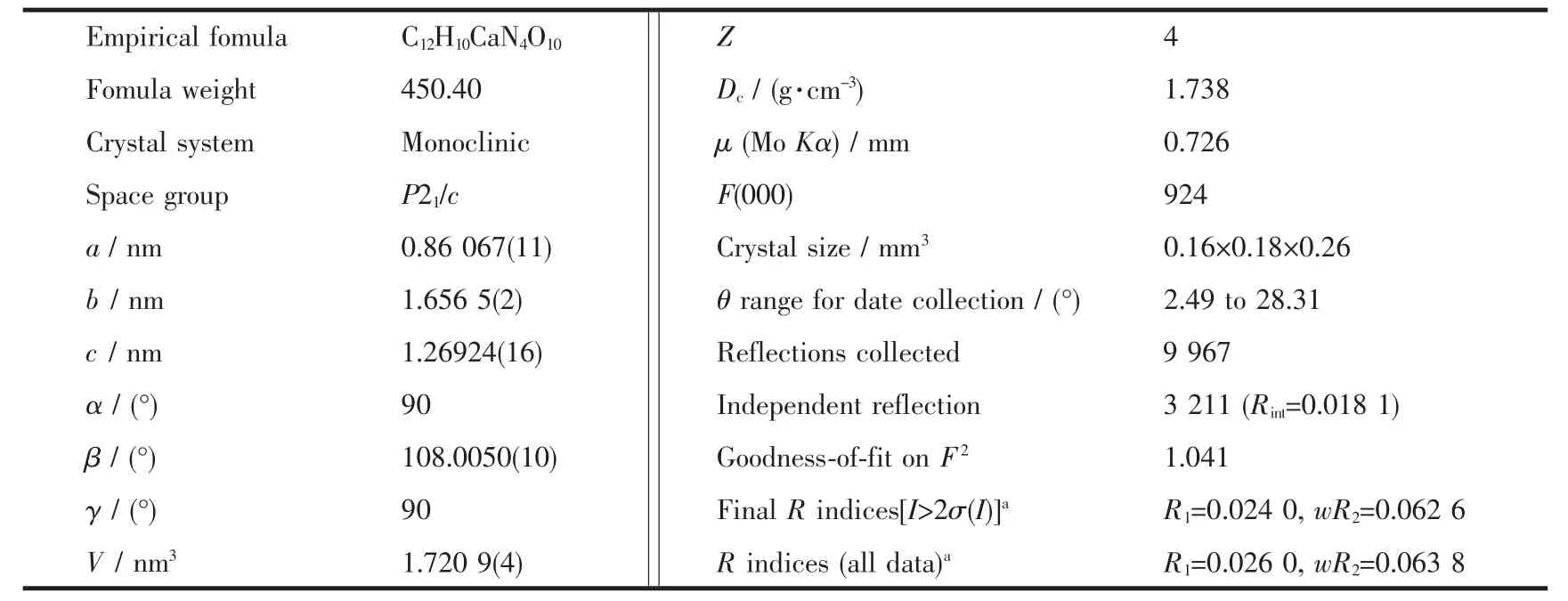
Table 1 Crystal and structure refinement data of 1
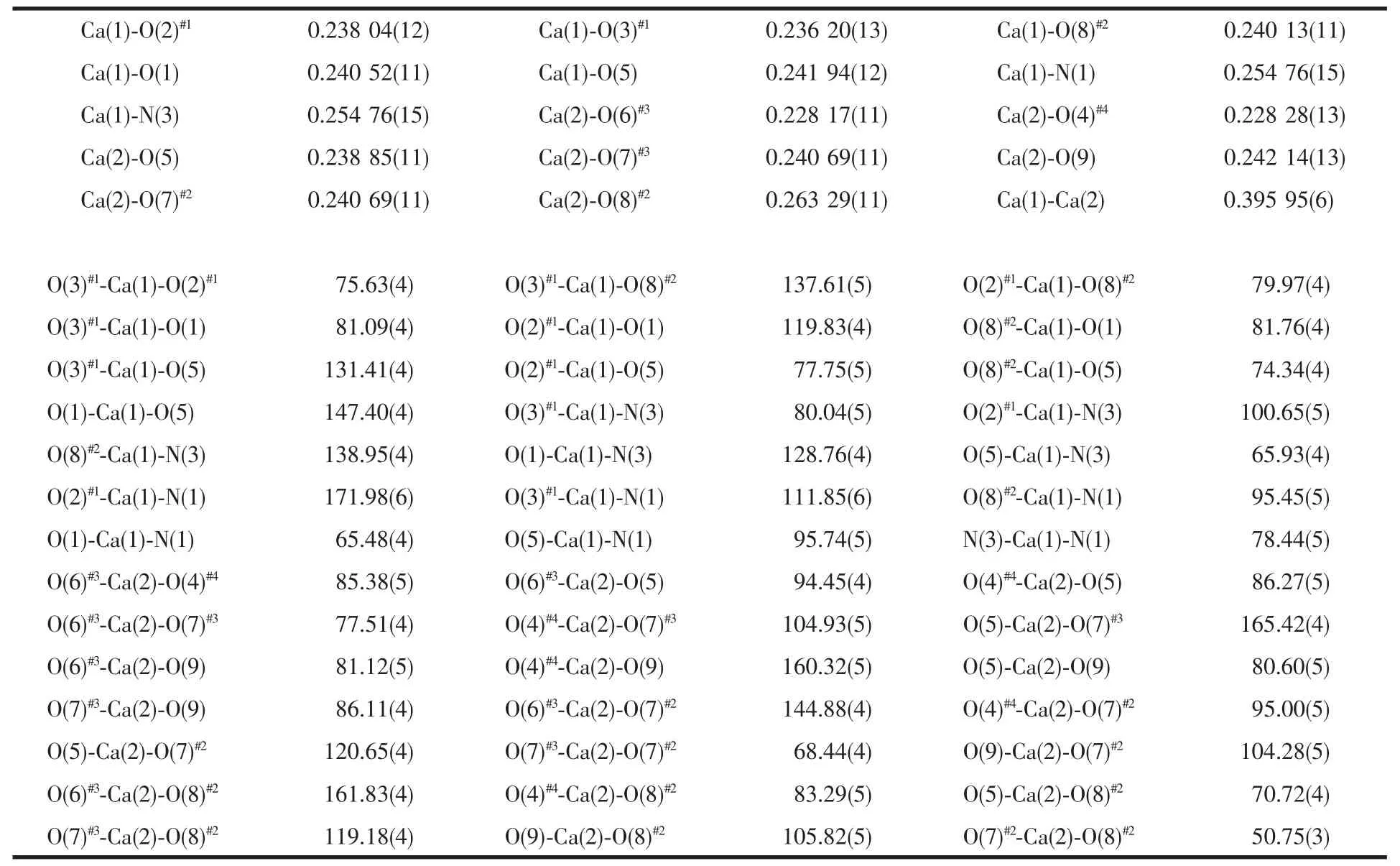
Table 2 Selected bond lengths(nm)and bond angles(°)of 1

Table 3 Hydrogen bond lengths and bond angles
CCDC:869134.
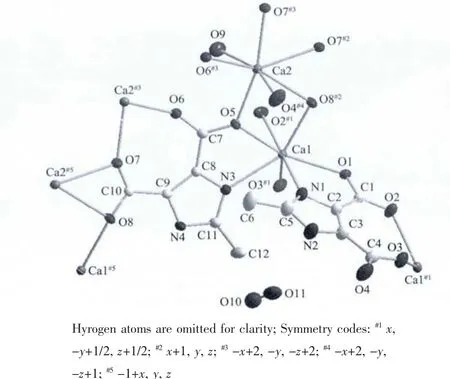
Fig.1 Crystal structure of 1 with 50%thermal ellipsoids
1.4 Antibacterial activities of complex 1
The antibacterial activities of the ligand and its complex was studied using the Kirby-Bauer(K-B)method.The strains selected were the botanical bacteria,including Penicillium italicum,Penicillium digitatum,and Magnaporthe oryzae.
2 Results and discussion
2.1 Description of the structure
Single crystal X-ray diffraction analysis reveals that the structure of the title complex 1,{[Ca2(μ3-HMIA2-)(μ5-HMIA2-)(H2O)]·H2O}n(H3MIA=2-methyl-1H-imidazole-4,5-dicarboxylic acid) is binuclear complex,each asymmetric unit composed of two Ca(Ⅱ)cations,twobideprotonated HMIA2-ligands(μ3-HMIA2-andμ5-HMIA2-),one coordinated water and one uncoordinated water(Fig.1).Interestingly,two Ca(Ⅱ) cations are seven-coordinated,but two Ca(Ⅱ)cations show different coordination environments.It is rare that the same metal ions have different coordination environments in one molecular building block of one compound[29-32].Each Ca(1)cation is coordinated with one nitrogen atom(N(1))and three oxygen atoms(O(1),O(2)#1,O(3)#1)fromμ3-HMIA2-ligand,and one nitrogen atom(N(3))and two oxygen atoms(O(5),O(8)#2from μ5-HMIA2-ligand,forming a distorted pentagonal bipyramidal geometry.The Ca-N bond distances are 0.249 39(16)and 0.254 74(18)nm,the Ca-O bond distancesarein therange of 0.236 16(16)~0.241 93(14)nm,the N-Ca-N bond angles is 78.46(6)°,the N-Ca-O bond angles vary from 65.46(5)to 171.99(6)°and the O-Ca-O bond angles vary from 74.34(5)to 147.38(5)°(Table 1).Each Ca(2)cation is coordinated with one oxygen atom(O(4)#4)from μ3-HMIA2-ligand,four oxygen atoms(O(5),O(6)#3,O(7)#2,O(7)#3,O(8)#4)from μ5-HMIA2-ligand and one oxygen atom(O(9))from coordinated water,yielding a distorted pentagonal bipyramidal geometry.The Ca-O bond distances are in the range of 0.228 08(14)~0.248 09(13)nm,and the O-Ca-Obond anglesvaryfrom68.45(5)to165.42(5)°(Table 1).These angles further confirm the distorted coordination geometry of Ca(Ⅱ) in (1).μ3-HMIA2-and μ5-HMIA2-are full deprotonated,and Each μ3-HMIA2-andμ5-HMIA2-is quasi-planar,with the mean deviations from the planes being 0.003 7 and 0.007 93 nm,respectively.The μ3-HMIA2-and μ5-HMIA2-bridge the Ca(Ⅱ) ions in a asymmetrical mode,in which the μ3-HMIA2-and μ5-HMIA2-lies in a C2symmetry(Fig.1).
In 1,fourμ3-HMIA2-,two μ5-HMIA2-and eight Ca(II)ions form a molecular parallelepiped of[Ca8(μ3-HMIA)4(μ5-HMIA)2]4+(Fig.2),in which eight calcium are distributed in the vertices of the parallelepiped,two μ3-HIDC2-is on the equatorial plane,four μ5-HIDC2-is on the axial plane with the dihedral angles of 38.111°.The distances of Ca(1)…Ca(2),Ca(1)…Ca(2)#4,and Ca(1)…Ca(1)#5are 0.395 95,0.860 67,and 0.915 6 nmand theangles Ca(1)…Ca(2)…Ca(2)#5,Ca(1)…Ca(2)…Ca(1)#4Ca(2)#5…Ca(2)…Ca(1)#4are 75.485,91.039,100.676°,respectively.The μ5-HMIA2-ligand acts as octadentate (N1O7)in 1 and adopts a unique μ5-κN,O ∶κO ∶κO,O′∶κO,O′∶κO coordination mode.Each carboxlate oxygen atom(O(5),O(6)#3and O(8)#2)and imidazole nitrogen atom(N(3))fromμ5-HMIA2-links the neighboring parallelepipeds to form one-dimensional chain (Fig.3).The μ3-HMIA2-ligand acts aspentadentate (N1O4)in 1 and adopts a μ3-κN,O∶κO,O′∶κOcoordination mode[4](Scheme 1).Each carboxlate oxygen atom(O(1),O(4)#4)and imidazole nitrogen atom(N(1))fromμ3-HMIA2-ligand links the neighb-oring one-dimensional chains yielding a twodimensional network layer framework.Two carboxlate oxygen atoms(O(2),O(3))fromμ3-HMIA2-ligand links the Ca(1)from the neighboring two-dimensional network layer framework to form a three-dimensional metal-organic frameworks(MOFs).The 3D MOFs is alsostabilized by the intermoleculer O-H…Ohydrogen bonds between the coordination water and the carboxyl group and the intermoleculer N-H…O hydrogen bonds between imidazole ring and the carboxyl group(Table 2).
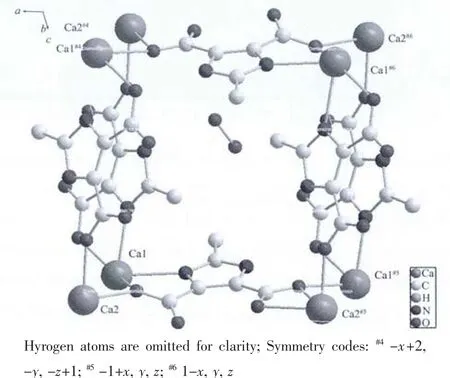
Fig.2 Parallelepiped structure of 1 with 50%thermal ellipsoids
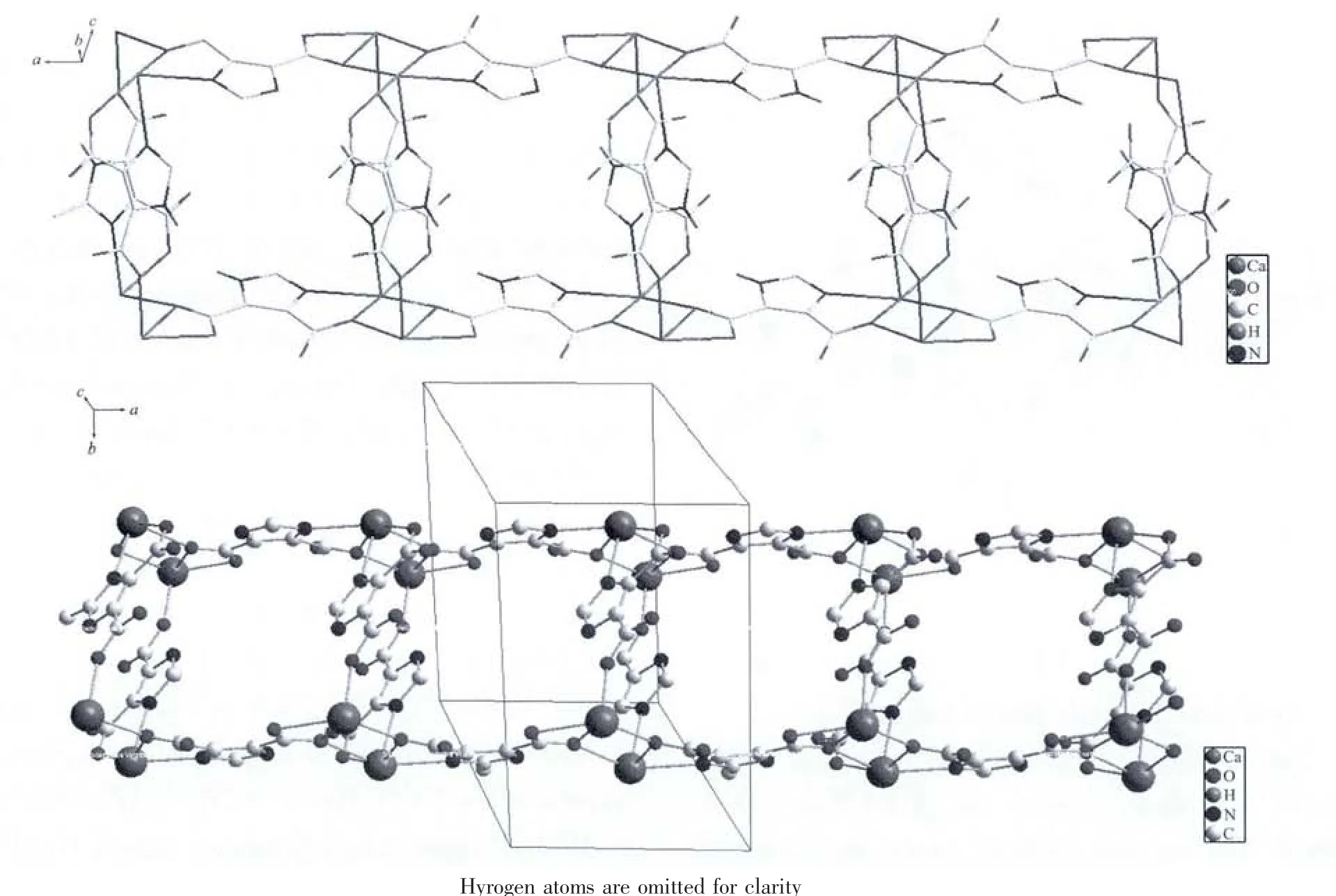
Fig.3 One dimensional metal-organic frameworks(MOFs)of 1
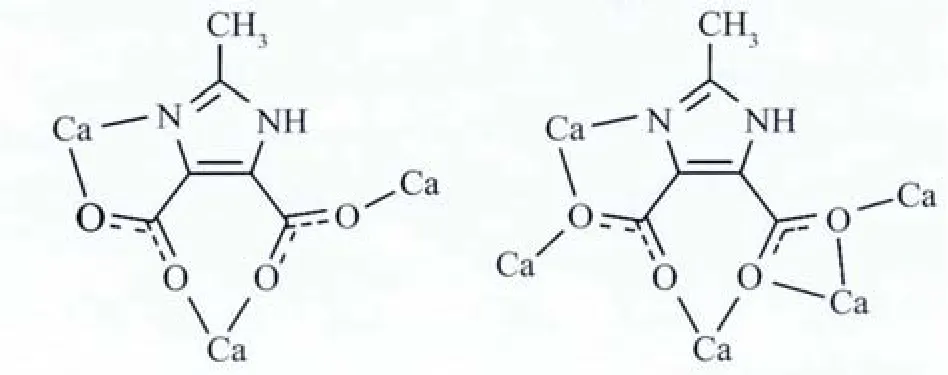
Scheme 1 Coordination codes ofμ3-HMIA2-and μ5-HMIA2-ligand
2.2 TGA analysis
The TGA data of 1 indicate two obvious weight losses shown in Fig.4.The first weight loss starts at 200 ~300 ℃ to give a total weight loss of 11.13%(Calcd. 8.04%),corresponding to the loss of coordinated water and uncoordinated water molecules.And then at 300~800 ℃ to give a total weight loss of 63.97% (Calcd.66.95%),attributed to the removal of H3MIA ligands and the final product is CaO with the weight of 24.90%(Calcd.25.01%).
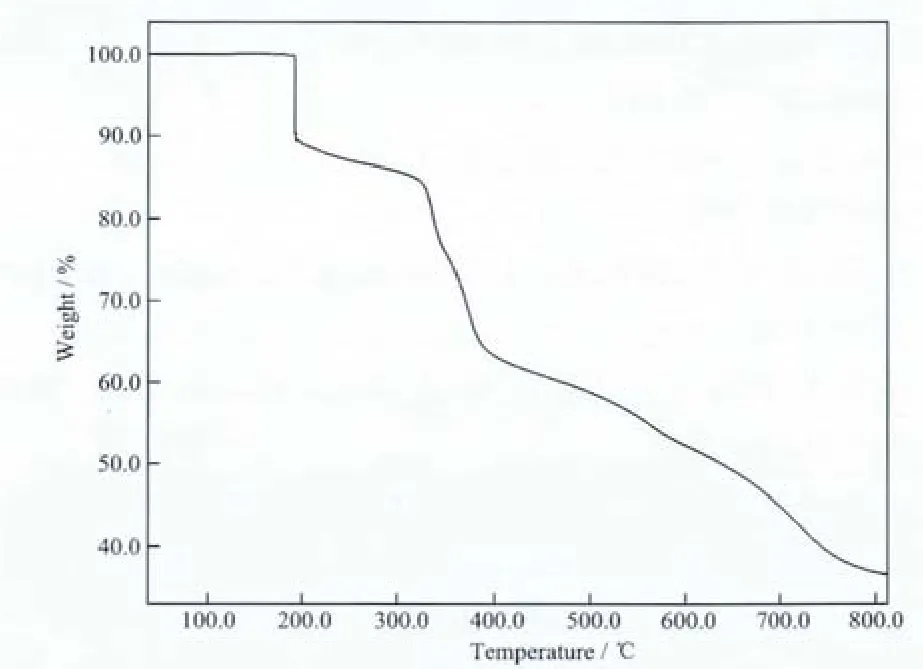
Fig.4 TGA curve of 1
2.3 Biological activity
The result of the bacterial growth inhibition study is reported in Table 4 in terms of the average diameter of inhibition zone.The result shows that the ligand and complex show antimicrobial activity to Penicillium italicum,Penicillium digitatum,and Rhizoctonia solani,and the effecct strengthens with increasing of the concentration.The complex shows better activity than the ligand to Penicillium italicum and Rhizoctonia solani,but shows poorer activity than the ligand to Penicillium digitatum,calcium ions may have promoting effect of on the growth to Penicillium digitatum.

Table 4 Antibacacterial data for the ligand and its complex
[1]Net G,Bayon J C,Butler W M,et al.Chem.Soc.Chem.Commun.,1989,15:1022-1023
[2]Liang Y C,Cao R,Hong M C.Inorg.Chem.Commun.,2002,5:366-368
[3]Bai Y L,Tao J,Huang R B,et al.Acta Cryst.,2005,C61:m98-100
[4]Lu W G,Jiang L,Feng X L,et al.Cryst.Growth Des.,2006,6:564-571
[5]ZHANG Xian-Fa(张现发),GAO Shan(高山),HUO Li-Hua(霍丽华),etal.Chinese J.Inorg.Chem.(Wuji Huaxue Xuebao),2006,22(1):139-141
[6]Yue Y F,Gao E Q,Fang C J,et al.Cryst.Growth Des.,2008,8(9):3295-3301
[7]Zhang F W,Li Z F,Ge T Z,et al.Inorg.Chem.,2010,49:3776-3788
[8]Feng X,Zhao J S,Liu B.et al.Cryst.Growth Des.,2010,10:1399-1408
[9]LI Shi-Jie(李世杰),SONGWen-Dong(宋文东),MIAODong-Liang(苗东亮),et al.Chinese J.Inorg.Chem.(Wuji Huaxue Xuebao),2011,27(10):2088-2094
[10]LIUHong-Wen(刘宏文),RUWen-Guan(卢文贯).Chinese J.Inorg.Chem.(Wuji Huaxue Xuebao),2011,27(9):1810-1816
[11]YUAN Li(袁立),RU Wen-Guan(卢文贯).Chin.J.Inorg.Chem.(Wuji Huaxue Xuebao),2011,27(7):1324-1328
[12]Zou R Q,Sakurai H,Xu Q.Angew.Chem.Int.Ed.,2006,45:2542-2546
[13]Sun Y Q,Yang GY.Dalton Trans.,2007:3771-3781
[14]Lu W G,Gu J Z,Jiang L,et al.Cryst.Growth Des.,2008,8:986-994
[15]Fang R Q,Zhang X M.Inorg.Chem.,2006,45:4801-4810
[16]Wang S,Zhang L R,Li G H,et al.Cryst.Eng.Comm.,2008,10:1662-1666
[17]Liu H,Qin H,Zhong X M,et al.Chin.J.Struct.Chem.,2011,30(7):1030-1036
[18]Song J F,Zhou R S,Hu T P,et al.J.Coord.Chem.,2010,63:4201-4214
[19]Liu CB,Nie X L,Wen H L.Acta Cryst.,2007,E63:m2244-2246
[20]Nie X L,Wen H L,Wu Z S,et al.Acta Cryst.,2007,E63:m753-755
[21]Wen H L,Lai B W,Wu X Q,et al.Kristallogr.NCS.,2009,224:455-456
[22]Tu Y G,Xiong Z Q,Song X Y,et al.Chin.J.Struct.Chem.,2011,30(12):1770-1774
[23]Nie X L,Xiong Z Q,Tu Y G.Kristallogr.NCS.,2012,227:335-336
[24]Phillips M.A.J.Chem.Soc.,1928:2393-2399
[25]Guo Y P.Acta Cryst.,2009,E65:o22[DOI:10.1107/S1600536808040221]
[26]Bruker.APEX2,SAINT and SADABS.Bruker AXS Inc,Madison,Wisconsin,USA 2005.
[27]Sheldrick G M.SHELXS 97,Program for Crystal Structure Solution,University of Göttingen,Germany,1997.
[28]Sheldrick G M.SHELXL-97,Program for X-ray Crystal Structure Refinement,University of Göttingen,Germany,1997.
[29]Zhang L Y,Zhang J P,Lin Y Y,et al.Cryst.Growth Des.,2006,6:1684-1689
[30]Liu G X,Huang Y Q,Chu Q,et al.Cryst.Growth Des.,2008,8:3233-3245
[31]Basak S,Sen S,Marschner C,et al.Polyhedron.,2008,27(4):1193-1200
[32]WANG Juan(王 娟),SU Jin-Xiong(苏 进 雄),TANG Xia(唐霞),et al.Chinese J.Inorg.Chem.(Wuji Huaxue Xuebao),2011,27(5):957-962
